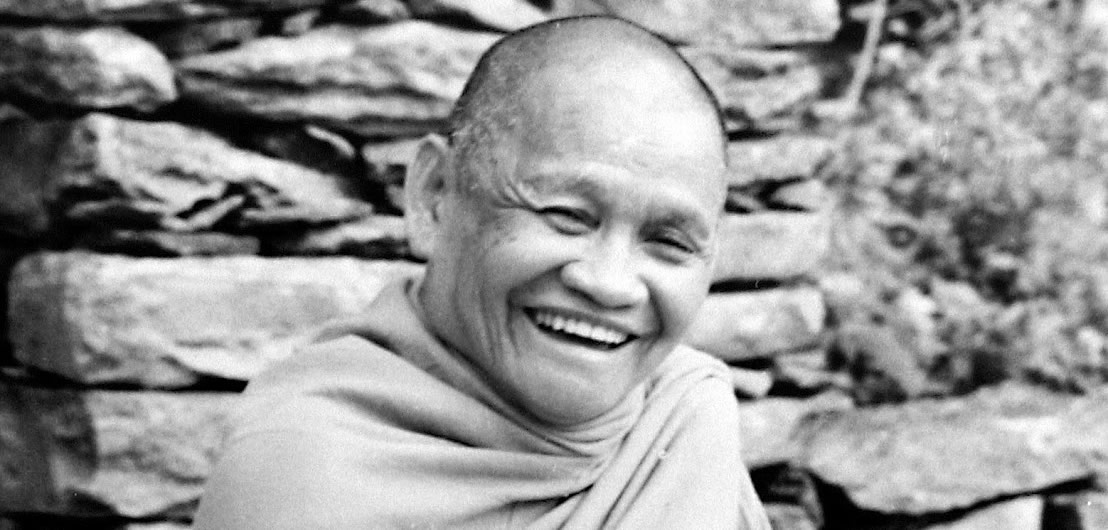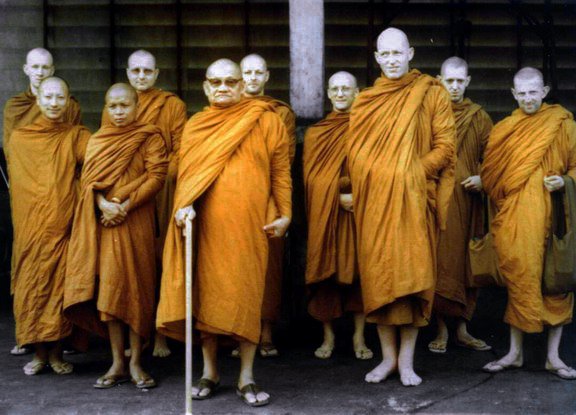Venerable Ajahn Chah (Phra Bodhiñāna Thera) was born into a typical farming family in a rural village in the province of Ubon Rachathani, N.E. Thailand, on June 17, 1918.

He lived the first part of his life as any other youngster in rural Thailand, and, following the custom, took ordination as a novice in the local village monastery for three years, where he learned to read and write, in addition to studying some basic Buddhist teachings. After this he returned to the lay life to help his parents, but, feeling an attraction to the monastic life, at the age of twenty (on April 26, 1939) he again entered a monastery, this time for higher ordination as a bhikkhu, or Buddhist monk.
He spent the first few years of his bhikkhu life studying some basic Dhamma, discipline, Pāli language and scriptures, but the death of his father awakened him to the transience of life. It caused him to think deeply about life's real purpose, for although he had studied extensively and gained some proficiency in Pāli, he seemed no nearer to a personal understanding of the end of suffering.
Feelings of disenchantment set in, and a desire to find the real essence of the Buddha's teaching arose. Finally (in 1946) he abandoned his studies and set off on mendicant pilgrimage. He walked some 400 km to Central Thailand, sleeping in forests and gathering almsfood in the villages on the way. He took up residence in a monastery where the vinaya (monastic discipline) was carefully studied and practiced.
While there he was told about Venerable Ajahn Mun Bhuridatto, a most highly respected Meditation Master. Keen to meet such an accomplished teacher, Ajahn Chah set off on foot for the Northeast in search of him. He began to travel to other monasteries, studying the monastic discipline in detail and spending a short but enlightening period with Venerable Ajahn Mun, the most outstanding Thai forest meditation master of this century. At this time Ajahn Chah was wrestling with a crucial problem. He had studied the teachings on morality, meditation and wisdom, which the texts presented in minute and refined detail, but he could not see how they could actually be put into practice. Ajahn Mun told him that although the teachings are indeed extensive, at their heart they are very simple. With mindfulness established, if it is seen that everything arises in the heart-mind: right there is the true path of practice. This succinct and direct teaching was a revelation for Ajahn Chah, and transformed his approach to practice. The Way was clear.
.jpg)
For the next seven years Ajahn Chah practiced in the style of an ascetic monk in the austere Forest Tradition, spending his time in forests, caves and cremation grounds, ideal places for developing meditation practice. He wandered through the countryside in quest of quiet and secluded places for developing meditation. He lived in tiger and cobra infested jungles, using reflections on death to penetrate to the true meaning of life.
On one occasion he practiced in a cremation ground, to challenge and eventually overcome his fear of death. Then, as he sat cold and drenched in a rainstorm, he faced the utter desolation and loneliness of a homeless monk.
After many years of travel and practice, he was invited to settle in a thick forest grove near the village of his birth. This grove was uninhabited, known as a place of cobras, tigers and ghosts, thus being as he said, the perfect location for a forest monk. Venerable Ajahn Chah's impeccable approach to meditation, or Dhamma practice, and his simple, direct style of teaching, with the emphasis on practical application and a balanced attitude, began to attract a large following of monks and lay people. Thus a large monastery formed around Ajahn Chah as more and more monks, nuns and lay-people came to hear his teachings and stay on to practice with him.
Ajahn Chah's simple yet profound style of teaching has a special appeal to Westerners, and many have come to study and practice with him, quite a few for many years. In 1966 the first westerner came to stay at Wat Nong Pah Pong, Venerable Sumedho Bhikkhu. The newly ordained Venerable Sumedho had just spent his first vassa ('Rains' retreat) practicing intensive meditation at a monastery near the Laotian border.
Although his efforts had borne some fruit, Venerable Sumedho realized that he needed a teacher who could train him in all aspects of monastic life. By chance, one of Ajahn Chah's monks, one who happened to speak a little English visited the monastery where Venerable Sumedho was staying. Upon hearing about Ajahn Chah, he asked to take leave of his preceptor, and went back to Wat Nong Pah Pong with the monk. Ajahn Chah willingly accepted the new disciple, but insisted that he receive no special allowances for being a Westerner. He would have to eat the same simple almsfood and practice in the same way as any other monk at Wat Nong Pah Pong.
The training there was quite harsh and forbidding. Ajahn Chah often pushed his monks to their limits, to test their powers of endurance so that they would develop patience and resolution. He sometimes initiated long and seemingly pointless work projects, in order to frustrate their attachment to tranquility. The emphasis was always on surrender to the way things are, and great stress was placed upon strict observance of the vinaya.
From that time on, the number of foreign people who came to Ajahn Chah began to steadily increase. By the time Venerable Sumedho was a monk of five vassas, and Ajahn Chah considered him competent enough to teach, some of these new monks had also decided to stay on and train there. In the hot season of 1975, Venerable Sumedho and a handful of Western bhikkhus spent some time living in a forest not far from Wat Nong Pah Pong. The local villagers there asked them to stay on, and Ajahn Chah consented. The Wat Pah Nanachat ('International Forest Monastery') came into being, and Venerable Sumedho became the abbot of the first monastery in Thailand to be run by and for English-speaking monks.

In 1977, Ajahn Chah and Ajahn Sumedho were invited to visit Britain by the English Sangha Trust, a charity with the aim of establishing a locally-resident Buddhist Sangha. Seeing the serious interest there, Ajahn Chah left Ajahn Sumedho (with two of his other Western disciples who were then visiting Europe) in London at the Hampstead Vihara. He returned to Britain in 1979, at which time the monks were leaving London to begin Chithurst Buddhist Monastery in Sussex. He then went on to America and Canada to visit and teach.
In 1980 Venerable Ajahn Chah began to feel more accutely the symptoms of dizziness and memory lapse which had plagued him for some years. In 1980 and 1981, Ajahn Chah spent the 'rains retreat' away from Wat Nong Pah Pong, since his health was failing due to the debilitating effects of diabetes. As his illness worsened, he would use his body as a teaching, a living example of the impermanence of all things.
Venerable Ajahn Chah passed away on the 16th of January, 1992, at the age of 74, leaving behind a thriving community of monasteries and lay suporters in Thailand, England, Switzerland, Italy, France, Australia, New Zealand, Canada and the U.S.A, where the practise of the Buddha's teachings continues under the inspiration of this great meditation teacher.
